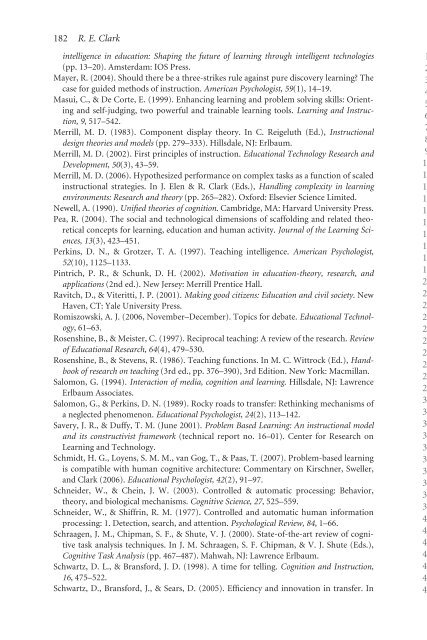9 How Much and What Type of Guidance is Optimal for Learning ...
9 How Much and What Type of Guidance is Optimal for Learning ...
9 How Much and What Type of Guidance is Optimal for Learning ...
Create successful ePaper yourself
Turn your PDF publications into a flip-book with our unique Google optimized e-Paper software.
182 R. E. Clarkintelligence in education: Shaping the future <strong>of</strong> learning through intelligent technologies(pp. 13–20). Amsterdam: IOS Press.Mayer, R. (2004). Should there be a three- strikes rule against pure d<strong>is</strong>covery learning? Thecase <strong>for</strong> guided methods <strong>of</strong> instruction. American Psycholog<strong>is</strong>t, 59(1), 14–19.Masui, C., & De Corte, E. (1999). Enhancing learning <strong>and</strong> problem solving skills: Orienting<strong>and</strong> self- judging, two powerful <strong>and</strong> trainable learning tools. <strong>Learning</strong> <strong>and</strong> Instruction,9, 517–542.Merrill, M. D. (1983). Component d<strong>is</strong>play theory. In C. Reigeluth (Ed.), Instructionaldesign theories <strong>and</strong> models (pp. 279–333). Hillsdale, NJ: Erlbaum.Merrill, M. D. (2002). First principles <strong>of</strong> instruction. Educational Technology Research <strong>and</strong>Development, 50(3), 43–59.Merrill, M. D. (2006). Hypothesized per<strong>for</strong>mance on complex tasks as a function <strong>of</strong> scaledinstructional strategies. In J. Elen & R. Clark (Eds.), H<strong>and</strong>ling complexity in learningenvironments: Research <strong>and</strong> theory (pp. 265–282). Ox<strong>for</strong>d: Elsevier Science Limited.Newell, A. (1990). Unified theories <strong>of</strong> cognition. Cambridge, MA: Harvard University Press.Pea, R. (2004). The social <strong>and</strong> technological dimensions <strong>of</strong> scaffolding <strong>and</strong> related theoreticalconcepts <strong>for</strong> learning, education <strong>and</strong> human activity. Journal <strong>of</strong> the <strong>Learning</strong> Sciences,13(3), 423–451.Perkins, D. N., & Grotzer, T. A. (1997). Teaching intelligence. American Psycholog<strong>is</strong>t,52(10), 1125–1133.Pintrich, P. R., & Schunk, D. H. (2002). Motivation in education- theory, research, <strong>and</strong>applications (2nd ed.). New Jersey: Merrill Prentice Hall.Ravitch, D., & Viteritti, J. P. (2001). Making good citizens: Education <strong>and</strong> civil society. NewHaven, CT: Yale University Press.Rom<strong>is</strong>zowski, A. J. (2006, November–December). Topics <strong>for</strong> debate. Educational Technology,61–63.Rosenshine, B., & Me<strong>is</strong>ter, C. (1997). Reciprocal teaching: A review <strong>of</strong> the research. Review<strong>of</strong> Educational Research, 64(4), 479–530.Rosenshine, B., & Stevens, R. (1986). Teaching functions. In M. C. Wittrock (Ed.), H<strong>and</strong>book<strong>of</strong> research on teaching (3rd ed., pp. 376–390), 3rd Edition. New York: Macmillan.Salomon, G. (1994). Interaction <strong>of</strong> media, cognition <strong>and</strong> learning. Hillsdale, NJ: LawrenceErlbaum Associates.Salomon, G., & Perkins, D. N. (1989). Rocky roads to transfer: Rethinking mechan<strong>is</strong>ms <strong>of</strong>a neglected phenomenon. Educational Psycholog<strong>is</strong>t, 24(2), 113–142.Savery, J. R., & Duffy, T. M. (June 2001). Problem Based <strong>Learning</strong>: An instructional model<strong>and</strong> its constructiv<strong>is</strong>t framework (technical report no. 16–01). Center <strong>for</strong> Research on<strong>Learning</strong> <strong>and</strong> Technology.Schmidt, H. G., Loyens, S. M. M., van Gog, T., & Paas, T. (2007). Problem- based learning<strong>is</strong> compatible with human cognitive architecture: Commentary on Kirschner, Sweller,<strong>and</strong> Clark (2006). Educational Psycholog<strong>is</strong>t, 42(2), 91–97.Schneider, W., & Chein, J. W. (2003). Controlled & automatic processing: Behavior,theory, <strong>and</strong> biological mechan<strong>is</strong>ms. Cognitive Science, 27, 525–559.Schneider, W., & Shiffrin, R. M. (1977). Controlled <strong>and</strong> automatic human in<strong>for</strong>mationprocessing: 1. Detection, search, <strong>and</strong> attention. Psychological Review, 84, 1–66.Schraagen, J. M., Chipman, S. F., & Shute, V. J. (2000). State- <strong>of</strong>- the- art review <strong>of</strong> cognitivetask analys<strong>is</strong> techniques. In J. M. Schraagen, S. F. Chipman, & V. J. Shute (Eds.),Cognitive Task Analys<strong>is</strong> (pp. 467–487). Mahwah, NJ: Lawrence Erlbaum.Schwartz, D. L., & Brans<strong>for</strong>d, J. D. (1998). A time <strong>for</strong> telling. Cognition <strong>and</strong> Instruction,16, 475–522.Schwartz, D., Brans<strong>for</strong>d, J., & Sears, D. (2005). Efficiency <strong>and</strong> innovation in transfer. In1234567891111111111222222222233333333334444444
















